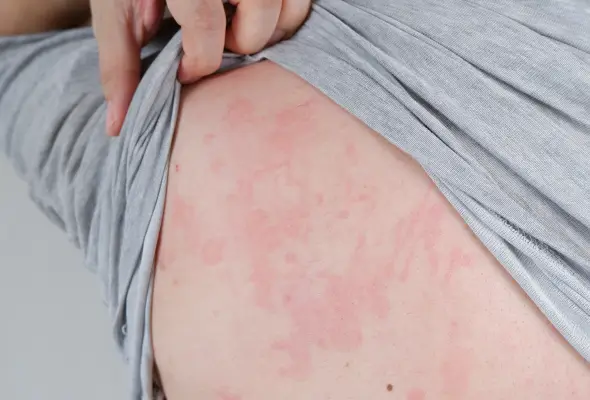-
Doctors
-
Specialities & Treatments
Centre of Excellence
Specialties
Treatments and Procedures
Hospitals & Directions HyderabadCARE Hospitals, Banjara Hills CARE Outpatient Centre, Banjara Hills CARE Hospitals, HITEC City CARE Hospitals, Nampally Gurunanak CARE Hospitals, Musheerabad CARE Hospitals Outpatient Centre, HITEC City CARE Hospitals, Malakpet
HyderabadCARE Hospitals, Banjara Hills CARE Outpatient Centre, Banjara Hills CARE Hospitals, HITEC City CARE Hospitals, Nampally Gurunanak CARE Hospitals, Musheerabad CARE Hospitals Outpatient Centre, HITEC City CARE Hospitals, Malakpet Raipur
Raipur
 Bhubaneswar
Bhubaneswar Visakhapatnam
Visakhapatnam
 Nagpur
Nagpur
 Indore
Indore
 Chh. Sambhajinagar
Chh. SambhajinagarClinics & Medical Centers
Book an AppointmentContact Us
Online Lab Reports
Book an Appointment
Consult Super-Specialist Doctors at CARE Hospitals

Anaphylaxis
Symptom, Causes, Diagnosis and Treatment
Anaphylaxis
Have you ever wondered what happens when your body overreacts to a seemingly harmless substance? Anaphylaxis is a severe and potentially life-threatening allergic reaction that can develop within seconds of exposure to certain triggers. This condition affects millions worldwide and requires immediate medical attention. Understanding anaphylaxis is crucial for recognising its symptoms and knowing how to respond effectively.
Let's understand the various aspects of anaphylaxis manifestations, causes, diagnosis and treatment approaches. We'll explore the different stages of this allergic reaction, discuss common risk factors, and highlight potential complications.

What is Anaphylaxis?
Anaphylaxis, also called anaphylactic shock, is a severe, life-threatening allergic reaction that influences multiple body systems. It occurs when the immune system overreacts to a trigger, releasing chemicals that cause a rapid and widespread response. This condition can develop within seconds or minutes after exposure to allergens such as food, insect stings, medications, or latex.
Anaphylaxis symptoms often include skin reactions, breathing difficulties, and a dangerous drop in blood pressure. Without prompt treatment, anaphylaxis can lead to respiratory collapse and even death. Doctors now use the term 'anaphylaxis' to describe both IgE-mediated and non-IgE-mediated reactions, as the clinical presentation and treatment are identical regardless of the underlying mechanism.
4 Stages of Anaphylaxis
Anaphylaxis typically progresses through distinct stages, each with increasing severity.
- Stage 1: In the initial stage, mild symptoms such as itching, skin redness, or a runny nose may occur.
- Stage 2: As the reaction advances, more widespread symptoms develop, including hives, facial swelling, and difficulty swallowing.
- Stage 3: The third stage marks a significant escalation, with breathing difficulties, weak pulse, and potential loss of consciousness. This stage is often referred to as anaphylactic shock.
- Stage 4: In the final, blood pressure drops dangerously, and airways continue to swell, potentially leading to a heart attack.
Recognising these stages as soon as possible is crucial, as anaphylaxis can rapidly progress within an hour of exposure, making prompt treatment essential to prevent severe complications.
Causes of Anaphylaxis
Anaphylaxis affects multiple body systems and can be triggered by various substances. Common anaphylaxis causes include:
- Food Allergies: Peanuts, milk, wheat, mushrooms, eggs, tree nuts, fish, and shellfish
- Medications: Certain antibiotics, NSAIDs, and radiocontrast agents
- Insect Stings: Insect bites from bees and wasps can cause severe reactions in some individuals.
- Pollen: Ragweed, grass, and tree pollen
- Latex Exposure: It is another potential cause of anaphylaxis shock, affecting doctors and others who frequently come into contact with rubber products.
- Exercise-induced Anaphylaxis: In rare cases, exercise or a combination of factors may trigger anaphylaxis.
- Identifying the specific cause is crucial to prevent future reactions.
Symptoms of Anaphylaxis
Anaphylaxis typically begins with skin symptoms such as hives or itching. Within minutes, more severe manifestations may develop, including:
- Swelling in the throat, lips, and tongue
- Shortness of breath
- Difficulty swallowing
- Red rash
- Abdominal pain
- Chest tightness
- Cramps
- Diarrhoea
- Vomiting.
- A feeling of impending doom often accompanies these symptoms.
In severe cases, life-threatening signs may occur, including:
- Light-headedness
- Confusion
- Increased heart rate
- Sudden weakness
- Unconsciousness
Symptoms usually start within five to 30 minutes of allergen exposure but can sometimes begin more than an hour later. Biphasic anaphylaxis, affecting about 20% of cases, involves a second wave of symptoms hours or days after the initial reaction subsides.
Diagnosis of Anaphylaxis
Diagnosing anaphylaxis is primarily clinical, based on the patient's symptoms and recent exposure to potential triggers. Doctors often rely on a set of criteria to identify anaphylaxis. These include the rapid onset of symptoms involving multiple body systems, such as skin reactions, respiratory issues, or a sudden drop in blood pressure.
Sometimes, an allergist may perform skin or blood tests to confirm specific allergies. However, these tests are not used to diagnose anaphylaxis itself. It's crucial to note that laboratory studies are generally unnecessary for immediate diagnosis, as prompt recognition and treatment are vital in managing this potentially life-threatening condition.
Treatment of Anaphylaxis
Epinephrine is the cornerstone of anaphylaxis treatment. It should be administered promptly via intramuscular injection into the thigh. This anaphylaxis medication counteracts the effects of immune mediators and stabilises mast cells. Other treatment approaches include:
- Antihistamines and corticosteroids are often used as adjunctive therapies, but they are not first-line treatments.
- Oxygen and intravenous fluids may be necessary to support breathing and blood pressure and lower swelling.
- In severe cases, doctors may give additional doses of epinephrine or a continuous infusion.
- Vasopressors or glucagon (in beta-blocked patients) may be considered for refractory anaphylaxis.
- After treatment, patients should be observed for potential biphasic reactions and provided with an emergency care plan.
Risk Factors
Several factors increase the likelihood of experiencing severe anaphylaxis, such as:
- Individuals with asthma, especially those with poorly controlled symptoms, face a higher risk.
- A history of previous anaphylactic reactions also raises the chances of future episodes.
- Age plays a role, with teenagers and older adults being more vulnerable.
- Cardiovascular ailments and chronic obstructive pulmonary disease (COPD) can worsen anaphylaxis outcomes.
- Additionally, taking medications like beta-blockers or angiotensin-converting enzyme inhibitors may increase the risk.
- The presence of cofactors, such as exercise, alcohol consumption, or acute infections, can amplify anaphylactic reactions by lowering the threshold for allergen exposure.
Complications
Anaphylaxis can lead to serious complications, especially when not treated promptly. The most severe outcome is death, which can occur due to respiratory failure or cardiovascular collapse. Other complications include:
- Hypoxemia, where blood oxygen levels drop dangerously low
- Hypotension, causing inadequate blood flow to vital organs
- Wheezing and stridor may develop, indicating severe airway obstruction.
- End-organ dysfunction can affect multiple systems, potentially causing long-term damage.
- People with underlying conditions such as heart disease or asthma face a higher risk of severe complications.
- Prompt recognition and treatment of anaphylaxis are crucial to prevent these life-threatening consequences and minimise the risk of long-term health issues.
When to See a Doctor
Individuals who have experienced any allergic reaction, even a mild one, should consult a doctor. This step is crucial to protect health and potentially save lives. A doctor can diagnose anaphylaxis based on symptoms and refer patients to an allergist for further testing. Allergists play a vital role in identifying triggers, teaching avoidance strategies, and providing a management plan for accidental exposures. After an acute anaphylactic reaction, seeking immediate medical attention is essential. Those with non-life-threatening symptoms may be observed for 4-6 hours, while severe cases might require hospital admission or ICU care. Seeking professional help ensures optimal management and reduces the risk of recurrent reactions.
Prevention
Preventing anaphylaxis focuses on avoiding known triggers. These include:
- For food allergies, this means carefully reading labels and informing others about allergies.
- Individuals allergic to medications should alert their doctors and explore safe alternatives.
- Those sensitive to insect stings should avoid bright clothing and walk barefoot in the grass. Venom immunotherapy can effectively reduce reactions to insect stings.
- For exercise-induced anaphylaxis, identifying and avoiding co-triggers is crucial.
- Patients with a history of anaphylaxis should carry an epinephrine autoinjector and wear medical alert jewellery.
- Education plays a vital role in prevention, helping patients understand hidden allergens, cross-reactions, and proper use of emergency medication.
Home Remedies for Anaphylaxis
Anaphylaxis always requires emergency medical care and should not be treated with home remedies alone. However, some complementary therapies may help lessen the severity of allergic reactions. These include:
- Over-the-counter antihistamines can relieve minor symptoms like hives or itching, but they cannot prevent anaphylaxis.
- Ice packs and topical creams containing corticosteroids may reduce swelling and itching.
- For food allergies, the best approach is to avoid trigger foods entirely.
- It's crucial to note that these measures do not replace professional medical treatment. Anyone experiencing symptoms of anaphylaxis should seek immediate emergency care and use an epinephrine autoinjector if prescribed.
Conclusion
Anaphylaxis has a significant impact on individuals worldwide, presenting a potentially life-threatening challenge that demands swift recognition and action.
Understanding the stages of anaphylaxis, identifying risk factors, and knowing how to prevent and manage this condition are crucial steps in safeguarding oneself and others from its potentially devastating consequences.
Armed with sufficient knowledge, individuals can better handle anaphylactic emergencies and take proactive measures to avoid triggers. Prompt medical attention is always necessary when dealing with anaphylaxis, and home remedies should never replace professional care. By staying informed and prepared, we can work together to minimise the risks associated with this serious medical condition and ensure better outcomes for those affected.
FAQ's
1. How can I recognise the signs of anaphylaxis in myself or others?
Key signs of anaphylaxis include:
- Difficulty breathing or wheezing
- Swelling of the throat, lips, or tongue
- Hives or widespread rash
- Dizziness or fainting
- Rapid, weak pulse
- Nausea, vomiting, or diarrhoea
2. What triggers anaphylaxis?
Common triggers include:
- Foods (e.g., peanuts, tree nuts, shellfish, eggs)
- Insect stings or bites
- Medications
- Latex
- Exercise (rarely)
3. How long does anaphylactic shock last?
Anaphylactic reactions typically peak within 5-30 minutes of exposure to the trigger. It can last for several hours or even days in severe cases without treatment.
4. What are the four stages of anaphylaxis?
Anaphylaxis doesn't always follow distinct stages, but it can be described in four phases:
- Early stage: Itching, hives, anxiety
- Progressive stage: Difficulty breathing, abdominal pain
- Life-threatening stage: Low blood pressure, shock
- Late phase reaction: Recurrence of symptoms after initial recovery
5. What happens during anaphylaxis?
During anaphylaxis, the immune system overreacts to an allergen, releasing chemicals that cause:
- Blood vessels dilate, leading to a drop in blood pressure
- Airways to constrict, making breathing difficult
- Fluid to leak into tissues, causing swelling
6. Can anaphylaxis go away on its own?
No, anaphylaxis requires immediate medical attention. While mild symptoms may occasionally subside, there's a risk of progression to severe, life-threatening reactions. Always seek emergency care.
7. What is the difference between an allergic reaction and anaphylaxis?
- Allergic reaction: Usually localised, milder symptoms (e.g., hives, itching)
- Anaphylaxis: Severe, potentially life-threatening reaction affecting multiple body systems
Still Have a Question?




